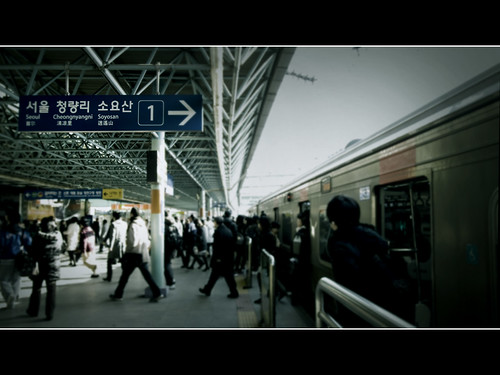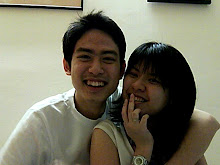Day #1 - Acquainting Seoul
»Day #2 - Korean Wave
Day #3 - A Sip of Soju
Day #4 - A Cultural Evening
21 February 2009, Saturday
I'm not a big fan of Korean drama. The only one I've ever watched is a 2005 drama with a peculiar title, "I'm Sorry I Love You (미안하다 사랑한다)". Surprisingly, I haven't watched Winter Sonata (겨울연가), which I believe is the most popular Korean drama. When the Korean wave hit the shores of Malaysia about six years back, every one was talking about it. Since then, there has been an onslaught of Korea dramas.
Like all its neighbouring countries, Japan, too, wasn't spared from the wave. In fact, Bae Yong Joon, the actor who starred in Winter Sonata immediately became so popular that he has his own cult of followers among the Japanese obasan's. He's elevated to the honorific status of "Yong-sama", and the filming location of the drama, Namiseom (남이섬; 南怡섬), became a pilgrimage site for Yong-sama's fans who visit Seoul.
Since my stay in Seoul was considerably long, Xiang Xing suggested that I made a day trip to the "holy land". Trusting my travel adviser's judgment, I set off to the island.

It's easier to get to the island by tour bus than by train. But since I only planned my trip the night before, it was too late to make any arrangements for that. So, train it was. Once you've gotten used to the complicated transportation system in Japan, travelling in Seoul wouldn't be much of a problem.
Here's some interesting facts about the Korean train system.
- Never sit down on the priority seat, whether there're old people around or not. You'll get angry stares from the other passengers, or even possibly, be reprimanded by someone.
- You can often see peddlers and preachers in the train, even though it is illegal. I met an old man who talked for five minutes in the train, trying to sell some book on Korean proverbs for 1000 Won.
- Station masters only appear on the platforms in rush hours. The rest of the time, they stay in the office. That explains why lost passengers have to ask for directions from strangers.
- Unlike in Japan, it is okay to talk on the phone during a train ride.
- Using a rechargeable card called T-money, you can transit for free between buses and trains.
"You like chicken or pizza?" one of them asked.
"He's a chicken house owner," another one pointed at his friend.
"He's my uncle."
I had no idea what they were talking about but I just entertained myself by talking cock too, in broken English.
Soon, the train came to a brief stop at Gapyeong, where I got off, while the gang continued their ride to Chuncheon.
"Sayounara!" they waved goodbye.
Gapyeong was short of road signs so I had problem finding the bus stop. Instead, I had to take a taxi to get to the ferry wharf. Though relatively cheap compared to Japan, it almost cost me a whopping 4000 Won.
Now, this may sound funny but Namiseom (나미섬, 'seom' by the way, means 'island') is an imaginary republic. They call it Naminara Republic (나미나라공화국). Normally, the "visa" for entering the island would cost 8000 Won, but for a limited period, it's 6000 Won. Still, my timing was a little bad because had I gone there a week later, it would be free for foreign visitors.
At the entrance of the island right after getting off the ferry was a curious chunk of ice, in front of which visitors snapped photos. I never found out about the significance of that artifact.
As expected, there wasn't much to see here in winter. Only bare trees and dried grass.
It was a surprise to see more Koreans than foreign tourists on the island. I expected throngs of Yong-sama's obasan fans. But no, most of them were Korean couples taking a romantic weekend escapade.

This lane lined up by red wood trees is one of the main film spots for Winter Sonata. Somehow, the atmosphere tugs on the heart strings. Strolling around the place aimlessly, I fantasized about stumbling upon my "fateful person". Damn, I knew Korean dramas poison the mind! After circling the island twice, I eventually gave up on the naive thought and decided to head back to central Seoul to spend the rest of the evening.
I had no particular plan in mind, so on the way back, I flipped through my guidebook, searching for somewhere to visit. Then I read about this performance which started in 1997 called Nanta (Cookin').

Nanta is a lively performance in which the performers creatively turn their kitchen items - pots, cooking pans, knives, chopping boards, brooms - into percussions. The story revolves around four cooks and a bad-tempered restaurant manager. One day, the restaurant receives an order to prepare a wedding banquet. The cooks are required to prepare ten dishes for the banquet in one hour, alongside the manager's nephew, who is basically just an annoying brat. Soon, the kitchen is thrown into a turmoil as the cooks rush to meet the deadline.
The group has gone to 27 countries in their world tour and I remember seeing them in Penang years ago. Not only was the performance energetic and comical, the way the performers cleverly involved the audience in the play made it even more entertaining. The 50,000 Won ticket was slightly pricey but the fun experience was totally worth the money.
Hmph, if only my mom hadn't forbidden me to play with my forks and spoons...

0 persons flung their shoes:
Post a Comment